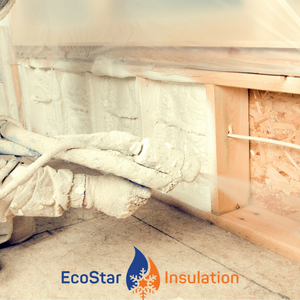Open Cell Vs. Closed Cell Spray Foam Insulation
Spray foam insulation has long been considered to be the best insulation available today. It is an insulation that grows in place and revolutionized the way we look at home insulation. It has been used in many commercial applications for years, and it is often one of the best choices for residential applications. There are 2 main types of spary foam insulation: open cell and closed cell. Each type provides a different level of energy efficiency benefits and has a slightly different application process. The decision to use either one will be based on your goals and requirements for addressing your insulation needs. Talk to EcoStars Spray Foam Insulation contractors today to learn more.
Background on Spray Foam Insulation
 Spray foam insulation is commonly mistaken for fibreglass insulation due to their similarities when installed. Spray foam insulation is manufactured when sulfur, resins, and water are mixed with the polyol resin in the presence of heat. Spray foam is also called open-cell spray foam insulation because its cells are open or continuous.
Spray foam insulation is commonly mistaken for fibreglass insulation due to their similarities when installed. Spray foam insulation is manufactured when sulfur, resins, and water are mixed with the polyol resin in the presence of heat. Spray foam is also called open-cell spray foam insulation because its cells are open or continuous.
Spray foam is considered one of the most versatile types of insulation due to its open cell structure that makes it ideal for sealing cracks and gaps around electrical wiring, plumbing, ductwork, attics, basements, and other places where air leaks can occur. Spray polyurethane foam is also used for building sound barriers to reduce outside noise pollution.
Open Cell
Open cell spray foam insulation is a type of spray foam insulation that incorporates small cells. The structure is created by blowing two types of chemicals through an expansion machine. These chemicals combine to create a foam-like substance that expands outwards and hardens to form an open cell structure. These cells do not close completely.
Closed Cell
Closed cell spray foam insulation is manufactured by the same method, but the results are closed cells. Open cell spray foam insulation results in open cells. Closed cell insulation is more durable, resists water vapor, and is used indoors in applications such as room additions, garages, crawl spaces, piers, or basements.
Open Cell vs Closed Cell R-Value
Open cell insulation is typically cheaper than closed-cell. It features a lower R-value because the foams are not quite as dense, meaning that they cannot provide as much protection against air leaks and heat transfer to the living space.
The most popular form of open cell insulation is cellular polyurethane (PU) which uses small bubbles for reinforcement, or expanded polystyrene -which appears similar to puffed up styrofoam peanuts. The higher density can be 25% less expensive than closed-cell products, but these materials also have a shorter lifespan before needing replacement.
Price aside, there is one downside to this type of material that could sway people into choosing the more expensive option – safety. While both have fire retardant characteristics, PU has been known to outgas formaldehyde fumes when applied at shallow depths or with high water content during installation; it also does not last as long before breaking down in young children's
Final Word
EcoStar Insulation is a home insulation company specializing in spray foam insulation installation for attic insulation, basements, containers, and roofing. We employ experienced, highly trained installers who are committed to ensuring customer satisfaction. Spray foam insulation has long been considered to be the best insulation available today. It is an insulation that grows in place and revolutionizes the way we look at home insulation. It has been used in many commercial applications for years, and it is often one of the best choices for residential applications. Contact us today to schedule your insulation installation.



